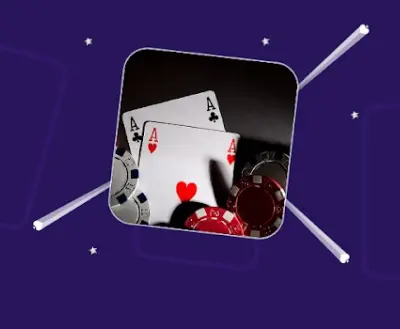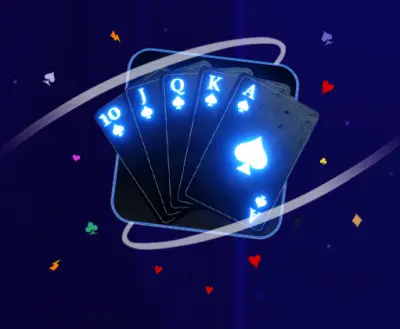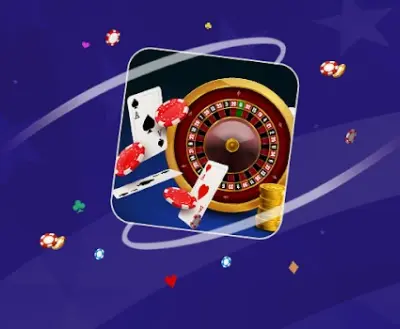What Are Poker Blinds?
Key Takeaways:
- Poker blinds are mandatory bets placed in games like No-Limit Hold'em and Pot-Limit Omaha before the cards are dealt. There are two types of blinds: the small blind and the big blind.
- Blinds play a crucial role in poker games, creating an incentive for players to join the pot and keeping the action moving in tournaments.
- A good tournament blind structure provides a generous starting stack of chips, with gradual increases between levels to allow for more strategy and skillful play.
- Players must adjust their strategy based on blind levels, transitioning from tight and solid poker in early stages to more aggressive play in middle stages, and utilising short-stack strategy in late stages.
- Poker blinds timers and tools are available in various formats, including smartphone apps, online timers, and physical devices, to help manage blind levels and ensure a smooth and fair game.
Diving into the world of poker can be an exciting and thrilling experience. But if you're new to the game, you might find yourself puzzled by some of the jargon thrown around at the table. One term you'll hear frequently is "poker blinds." No, it's not about your eyesight – it's about the game's mechanics! In this article, we'll shed light on poker blinds, helping you understand their purpose and how they work in various poker formats.

Understanding Poker Blinds
Poker blinds are mandatory bets placed in games like No-Limit Hold'em and Pot-Limit Omaha before the cards are dealt. There are two types of blinds: the small blind and the big blind. The small blind is posted by the player immediately to the left of the dealer button, while the big blind is posted by the player two seats to the left of the dealer button. The size of the blinds is predetermined and usually, the small blind is half the size of the big blind.
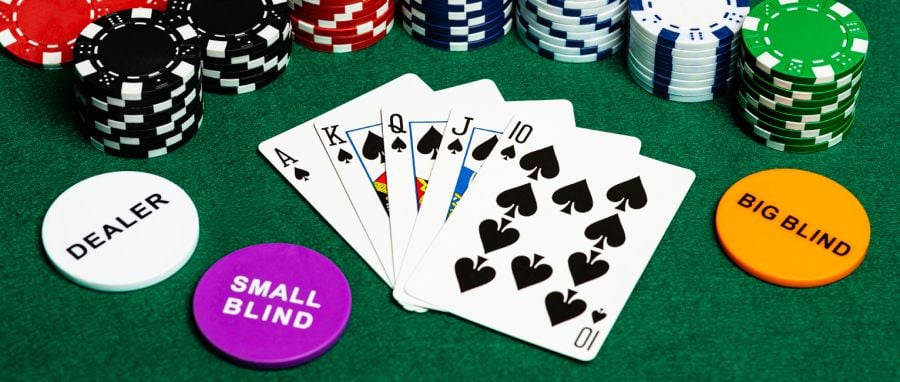
Why Are Blinds Important in Poker?
Blinds play a crucial role in flop games like Texas Hold'em and Omaha. In cash games, blinds remain constant and create an incentive for players to join the pot, as there's already money to be won.
In tournaments, blinds need to increase continually to keep the event from dragging on for days. With hundreds or even thousands of players participating in multi-table tournaments, rising blinds force players to accumulate chips and stay ahead of the competition.
What Makes a Good Tournament Blind Structure?
While there's no universally agreed-upon formula for a good tournament blind structure, some factors contribute to a better playing experience. Players tend to prefer structures that provide a generous starting stack of chips (100-250 big blinds) and feature gradual increases between levels. This allows players to engage in more poker strategy, rather than just going all-in or folding.
What is a good tournament blind structure?
There are no set rules for what determines if a tournament structure is good or not. Some players prefer fast or turbo structures where the blind levels are short, where others only like playing in tournaments with slow structures.
Typically, a good tournament blind structure sees players sit down with a generous starting stack of chips worth 100-250 big blinds, and where there are no significant increases between levels. For example, a tournament where the blinds went from 50/100, 75/150, 100/200 would be deemed good, but one with blinds of 50/100, 100/200, 250/500 would be terrible. Furthermore, a good tournament blind structure keeps the average stack size at such a level that players have room to play poker against each other instead of moving all-in or folding.
Example of a Blind Structure
Let's take a look at a sample blind structure for a PartyCasino tournament with a 50,000 starting stack. Notice how the blinds and antes increase gradually, ensuring steady action and an eventual conclusion:
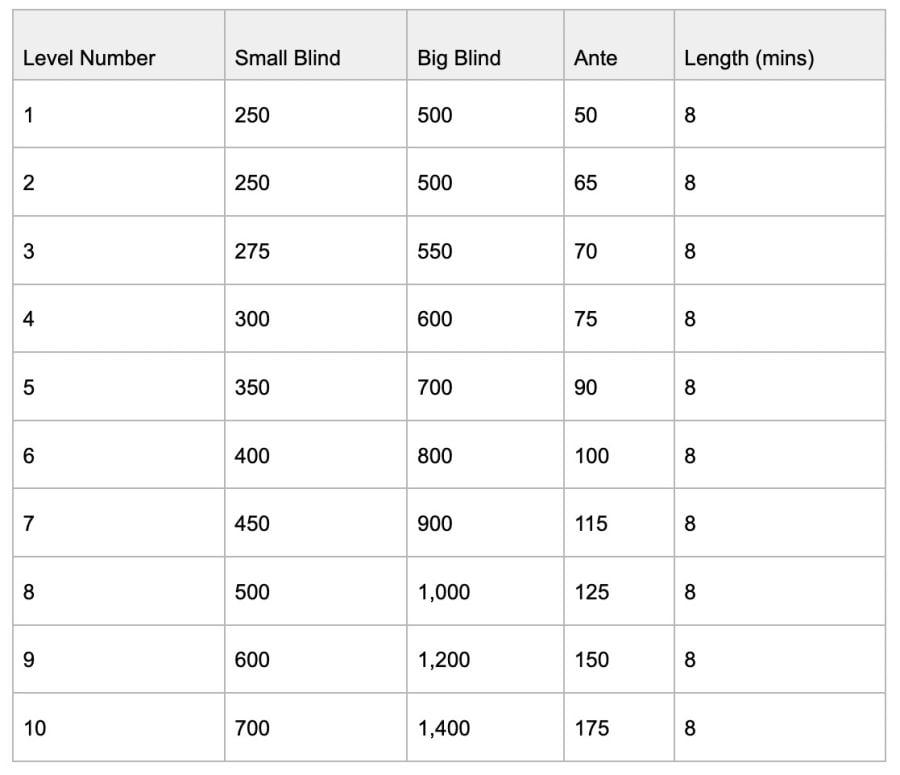
Poker Blinds Terminology
Starting stack – Your starting stack is the number of chips you receive when you enter a poker tournament. Most tournaments see players receive a starting stack with between 100-200 times the number of big blinds at the start of the event.
Blind increases – Blinds continually increase throughout a poker tournaments. The increasing cost forces the action, and ensures players are eliminated and the tournament reaches a conclusion in a timely manner.
Gradual blind increase – The best tournament structures see gradual blind increases rather than having large differences between the blind levels. Gradual increases keep the average stack size at a healthy number of big blinds. Gradual blind increases are preferred because it gives players more time to play poker and build up their stacks.
Big blind – The big blind is the forced bet paid by the player seated two seats to the left of the dealer; the big blind is usually twice the size of the small blind. Players measure their stacks in terms of the current big blind amount.
Missed blinds – You are deemed to have missed the blinds if you leave the table while you are seated in either the small blind or big blind seat. The dealer will still take your blinds if you are competing in a poker tournament even if you are sat out. However, things are slightly different in a cash game. If you sit out before the blinds reach you, and then return once they have passed you, you have missed the blinds. You are unable to receive hands until either the big blind reaches you, or you pay the blinds early. Nobody gets away with missing the blinds!
Blind periods/levels/round length – Blind periods, blind levels, and blinds round length are different terms for the same thing. They describe the time before the tournament blinds increase. For example, 20-minute levels would mean you play at the current blinds for 20 minutes before they increase.
Rebuys/Re-entries – Some tournaments allow players to rebuy or re-enter if they lose their initial stack. There is a predetermined length of time were rebuys and re-entries are permitted. You purchase the rebuy or re-entry, receive the starting stack, and continue playing.
Add-ons – Add-ons are a feature of rebuy tournaments where player can buy some additional chips once the rebuy period ends.
Antes – In addition to the small blind and big blind, most tournaments, and some cash games, have antes in play. Antes are forced bets that everyone at the table pays before cards are dealt. The size of antes varies, but are typically between 10-15% the size of the big blind.
Adjusting Your Strategy Based on Blinds
As the blinds increase, it's essential to adjust your poker strategy to stay competitive in the game. Here are some key points to keep in mind:
- Early stages: In the early stages of a tournament or cash game, when blinds are low relative to stack sizes, focus on playing tight and solid poker. Stick to premium hands and avoid over-committing chips with marginal holdings.
- Middle stages: As blinds increase and stack sizes start to dwindle, it's time to become more aggressive. Look for opportunities to steal blinds and antes, and widen your hand selection to include more speculative holdings.
- Late stages: When blinds are high, and stacks are shallow, short-stack strategy becomes crucial. Make moves to accumulate chips by shoving all-in or folding, and carefully pick your spots to maximise your chances of survival.
Poker Blinds Timer and Tools
A blinds timer is a useful tool for managing blinds in home games and informal poker gatherings. These timers help keep track of blind levels and ensure a smooth and fair game. Here are some popular tools and resources to help you:
- Poker Blinds Timer Apps: Several smartphone apps serve as blinds timers. They allow you to set the blind structure, length of levels, and breaks. Some popular apps include Poker Blind Timer, Travis Poker Timer, and Easy Poker Timer.
- Online Poker Blinds Timers: If you prefer using a web-based timer, websites like BlindValet.com and PokerDIY.com offer customizable blinds timers that can be accessed from any device with an internet connection.
- Physical Poker Timers: For those who prefer a more traditional approach, physical poker timers are available for purchase. These standalone devices function similarly to app-based timers but offer a more tactile experience.
Conclusion
Understanding poker blinds is essential for any poker player, whether you're a beginner or a seasoned pro. By grasping the concept of blinds, their purpose in poker games, and how to adjust your strategy based on blind levels, you'll be well on your way to becoming a more skilled and competitive player.
Don't forget to explore various blinds’ timers and tools to ensure a smooth and fair game in your home or casual poker sessions. So, what are you waiting for? Put your newfound knowledge into practice and start building your poker skills today by joining the action at PartyCasino, where you can enjoy a wide range of live poker games, suitable for all skill levels!




